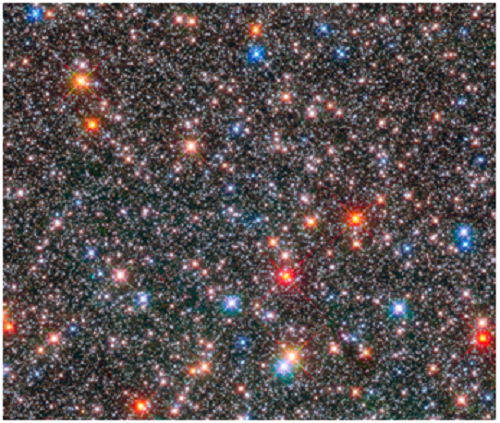在类太阳恒星中,高含量的锂元素罕见吗? 类太阳恒星会产生锂元素吗?它发生在恒星演化的哪个阶段? 中国科学院国家天文台赵刚研究员和Kumar博士领导的国际团队,利用我国重大科技基础设施郭守敬望远镜(LAMOST)光谱数据及国际GALAH巡天数据发现类太阳恒星经过氦闪后普遍可以产生锂元素,该发现解开了上述谜题。2020年7月6日,这一研究成果发表于国际天文期刊《自然·天文》(Nature Astronomy)。 论文链接:点击这里。
锂通常用于现代通讯设备和运输行业。手机、平板电脑、电动汽车等都使用锂电池供电。此外,锂元素还被大量应用于航空航天、国防军工等领域。但你是否想过,锂元素从何而来? 绝大多数锂的起源可以追溯到同一个事件,那就是大约138亿年前发生的宇宙大爆炸,也就是宇宙的起源。锂是目前已知的在宇宙早期大爆炸中最早产生的三种元素之一(另外两种是氢和氦)。一直以来,锂元素是连接宇宙大爆炸、星际物质和恒星的关键元素,对锂元素的研究是宇宙和恒星演化的重要课题。
宇宙大爆炸时期的锂含量小幅增长,主要是由于高能宇宙射线轰击星际介质中较重的原子核,如碳和氧,将它们分裂成较小的原子,如锂。与其他元素不同,研究人员普遍认为锂元素将会在恒星中逐渐消失。这是由于锂在恒星内部相对较低的温度下(250万度,即一百万度的几倍)参与核反应,再经过与外部大气的混合,最初的锂就会在恒星生命周期中消失。比如太阳和地球的组成元素高度相似,且被认为几乎同时形成,但太阳中的锂含量却比地球中的锂含量低了100倍。随着观测技术的进步,人们陆续发现,部分类太阳恒星(在银河系中大约占1/100)大气中的锂含量非常高,在某些情况下,甚至比理论模型预测高出10万倍。到底什么原因导致了类太阳恒星中锂含量异常升高?这个问题在过去四十年里一直困扰着研究人员。
借助GALAH、LAMOST和GAIA巡天数据,研究团队发现了类太阳恒星经过氦闪后普遍可以产生锂元素,解开了上述谜团。论文第一作者Kumar博士说:研究团队系统地研究了晚期类太阳恒星中锂丰度异常升高的现象。令人惊讶的是,类太阳恒星经过氦闪后锂丰度异常升高的现象极为普遍。氦闪是类太阳恒星中的一个标志性事件,在恒星演化的晚期,其核心不断积累氦元素,并导致温度和压力持续上升。这个巨大的氦核最终被点燃,发生剧烈失控地核燃烧,就像在恒星内部引爆了一颗氦原子弹,在几分钟内释放出相当于整个银河系的能量。理论模型预测经历此阶段的恒星锂含量应该非常低,但实际上,观测却发现这些恒星的锂含量平均高出理论预测值的200多倍,这表明类太阳恒星通过氦闪产生了新的锂元素。由于氦闪是类太阳恒星演化过程中必然会经历的过程,因此类太阳恒星经过氦闪后普遍会产生锂元素。LAMOST数据在鉴别氦闪恒星的过程中发挥了重要作用。
此外,该研究还提出了一个新的标准来鉴别被称为富锂巨星的天体,照此标准,人们在过去40年间所发现的富锂巨星可能只是宇宙中的冰山一角。
据研究团队负责人、论文共同通讯作者赵刚研究员介绍,对我们而言,下一步研究的关键是了解锂在氦闪和混合机制之间的核聚变,这里依然包含着很多未解之谜。
国家天文科学数据中心为天文观测设备和研究计划提供数据与技术服务。

图1:恒星中锂元素从主序经过红巨星、氦闪(红巨星上端)到红团簇的氦核燃烧阶段的演化。虚线为模型预测。红色符号带代表红团簇星的氦核燃烧阶段。
注:目前宇宙大爆炸模型预测的原初值A(Li)=2.7dex(以对数尺度测量为A(Li)=log n(Li)/n(H) +12,其中n是原子数密度)作为原始或大爆炸值。在星际介质(ISM)或非常年轻的恒星中约为A(Li) = 3.3dex,比原初值多4倍。
Study reveals the secret life of Lithium in Sun-like stars: Created not just destroyed
Lithium is becoming common in our everyday lives. It is the key ingredient in the batteries of our mobile phones and electric vehicles, but have you ever wondered where it comes from?
A new study led by Prof. Gang Zhao and Dr. Yerra Bharat Kumar from National Astronomical Observatories of Chinese Academy of Sciences (NAOC) provides a fresh understanding of both how Lithium is made, and how it is destroyed.
This study was published in Nature Astronomy on July 6.
Researchers studied the Lithium content of hundreds of thousands of Sun-like stars to understand how this element changes over time in stars.
“Lithium is quite a special element,” Dr. Yerra Bharat Kumar said, who is the lead author of this study and is from NAOC.
“Our study challenges the idea that stars like the Sun only destroy Lithium through their lives,” he said.
“Our observations show that they actually create it later in their lives, after they have swelled to become red giants. This means that the Sun itself will also manufacture Lithium in the future.”
Lithium is only one of three elements produced in the BigBang. It gets destroyed very easily inside stars where it is too hot for it to survive, so stars generally reduce their Lithium content as they age.
Because it is such a sensitive element, it is very useful for understanding stars, and it acts as a tracer for what is happening inside stars.
To better understand this sensitive element, researchers used data from a huge Chinese stellar spectroscopic survey based on the Large Sky Area Multi-Object Fiber Spectroscopic Telescope (LAMOST). The survey is currently building a database of the spectra of ten million stars.
This study also uses Australian star survey known as GALAH.
“By looking at starlight, we can determine what the stars are made of” said Dr. Yerra Bharat Kumar.
“Models show that our current theories about how stars evolve do not predict this Lithium production at all. Thus, the study has created a tension between observations and theory.”
“Our findings will help us to better understand and model Sun-like stars,” said Prof. Gang Zhao from NAOC, who is the co-corresponding author of this study.
“Since the newly created Lithium will end up being blown off the star in stellar winds, it will also help us understand how these stars contribute to the Lithium content of our Galaxy, and hence to planets like Earth.”

Figure 2: This Hubble Space Telescope image shows stars at various stages of their lives, from young blue-hot stars to cooler red giants. Our study focused on the lithium content of red giant stars. Credit: NASA, ESA, and T. Brown (STScI).
新闻来源:http://www.nao.cas.cn/xwzx/kydt/202007/t20200707_5619691.html